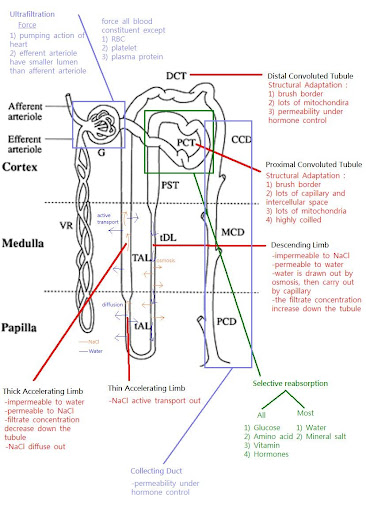
A) Principle :
bone + joint + muscle
Bone : Provide surface for muscle attachment
Bone and Joint : Forming lever system
Muscle : contraction provide effort to the lever system , Antagonistic pair of skeleton attached to bone to provide movements in opposite direction
B) Sliding-filament Hypothesis :


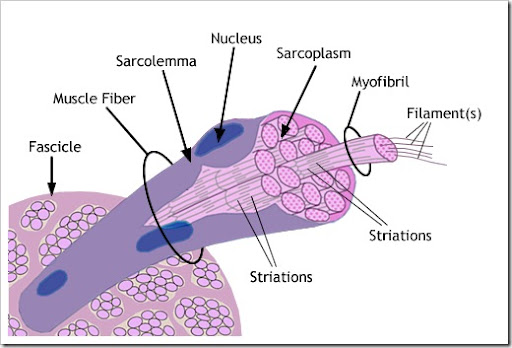

| Aquatic vertebrates | Terrestrial vertebrates |
| -Body weigh supported by water | -Body weigh support by limb with strong muscle |
| -No limb and strong muscle necessary | -Limb and strong muscle necessary |
| -Less energy required for support | -More energy required for support |
| -Appendages in forms of fin rays | -Appendages in form of limb |
| -pelvic girdle does not connected to vertebral column | -pelvic girdle connected to vertebral column |
A) Stomatic Growth :
Normal Growth :
1) Growth Horone :
2) Thyroxine :
Secondary Growth :
1) Testosterone :
2) Oestrogen :
B) Reproductive Growth :

A) Adrenaline :
B) Noradrenaline :
C) Thyroxine :
Anterior pituitary:
Posterior pituitary :
A) Basic concept :
Stimulation -> detection -> regulation -> effector -> correction
* negative feedback mechanism
Stimulate :
a) Directly (hypothalamus act as both detecter and regulator)
b) Indirectly (Detected by other organ and regulated by hypothalamus)
- Sensory nerve impulse :
- Nerve impulses from brain
Regulation :
a) Sending nerve impulses to effector :
b) Secreting hormone :
c) Secreting trophic hormone :
B) Major function :
Similarity
Difference
| Nervous System | Hormonal System |
| -Short term effect | -Long term effect |
| -Faster response | -Slower response |
| -Localized effect | -Wildspread effect |
| -Affect muscle and gland | -Affect metabolism and long term process |
| -electrochemical in nature | -chemical in nature |
A) Heart
1) Mechanism of heart beating :

2) Nerves control of heartbeat :

3) Cardiac cycle :

* Blood flow from high pressure to low pressure
B) Blood Vessel :
Structural Adaptation of Blood Vessel :
1) Arteries :


2) Vein :


3) Capillary :



C) Blood :
1) Oxygen dissociation curve :
 |
|
2) Bohr effect :
 |
(CO2 diffuse forms carbonic acid, carbonic acid dissoicate to liberate H+, H+ combine with haemoglobin to displace O2 ) |
3) Adaptation of organism :
For organism living in low oxygen tension atmosphere :
 |
|
For high metabolic organism :
 |
|
D) Lymph :
1) Mechanism of forming lymph :
2) Significant of lymph :
A) Mechanism :
1) Resting potential :

2) Action potential :
Arrival of action potential , which higher than threshold value
↓
Membrane is more permeable to Na+
↓
Rapid influx of Na+ across the membrane, and it is even enhanced, and it is even enhanced the permeability
↓
Depolarization begin (reversal of charge), action potential begin
↓
Reversal of charge cause decrease in permeability of Na+ and increase in permeability of K+
↓
K+ ion flow out cause Repolarization
↓
K+/Na+ pump pump K+ in and Na+ out restore resting potential



3) Transmittion between neurone :



4) Rate of Transmittion :


B) Brain :
1) Spinal cord :
2) Medulla :
3) Cerebellum :
4) Cerebrum :
C) ANS :
Comparsion between Sympathetic Nervous System and Parasymthetic Nervous System :
| Sympathetic Nerve System | Parasympathetic Nerve System |
| -Close to spinal cord | -Close to effectors |
| -Short preganglionic fibres, Long postganglionic fibres | -Long preganglionic fibres, Short postganglionic fibres |
| -Many postganglionic fibres | -Many preganglionic fibres |
| -Wide area effect | -Restricted area |
| -Widespread effect | -localized effect |
| -Excitatory homeostatic effect | -Inhibitory homeostatic effect |
| -Mobilizing energy for emergency use | -Save energy and restore to rest state |
| -Dominating during stressful | -Dominating during rest |
| -Noradrenaline | -Acetylcholine |

Adaptation for all transport :
1) large number of alveoli -> vary large surface area
2) thin layer of epidthellium -> short distance for diffusion
Adaptation for diffusion :
3) moist, covered by mucus -> dissolve and diffuse rapidly
4) covered by network of capillary -> oxygen can delivered to body rapidly , CO2 can delivered out the body rapidly, create steeply concentration gradient to fasten diffusion
5) low blood pressure in nearby capillary -> stay longer time for gaseous exchange
-photosynthesis require light, CO2 and H20 as substrate
1) Thin flat shape :
light :
CO2 :
2) Epidermis :
light :
water :
3) Palisade mesophyll cell :
light :
4) Spongy mesophyll cell :
CO2 :
5) Stomata :
CO2 :
Water :
6) Vein :
* think the structure of a leaf first
Regulation of plant growth and development by phytohormone
A) Germination :
-Gibberellin :
- Break seed dormancy
B) Growth :
-Auxin :
- Promote cell elongation in region of elongation
- Promote cell division in vascular cambrium
- Regulate phototropism and geotropism
-gibberellin :
- Promote stem elongation
C) Fruit development :
-Auxin :
- Stimulate fruit development even without fertilization
-Gibberellin :
- Stimulate fruit development even without fertilization

| Asexual Reproduction | Sexual Reporduction |
| -one parent only | -one / two parent(s) |
| -no gamete | -have gamete |
| -no meiosis | -have meiosis |
| -genetically indentical | -genetically different |
| -large offspring is produced | -smaller offspring is produced |
| -fast | -slow |
| -occur commonly in lower organism | -occur commonly in plant and animal |
Seed Dispersal :
A) Defination :
B) importance :
Seed Dormancy :
A) Defination :
B) importance :
A) Reduce water loss :
B) Storage :
C) Remove excess salt :
A) Reduce water loss : (Leaves)
Stomata :
Surface :
Leaves shape :
B) Storage :
C) Increase water uptake : (Root)
A) Temperature :
B) pH :
C) Light :
D) Oxygen tension :

Mechanism

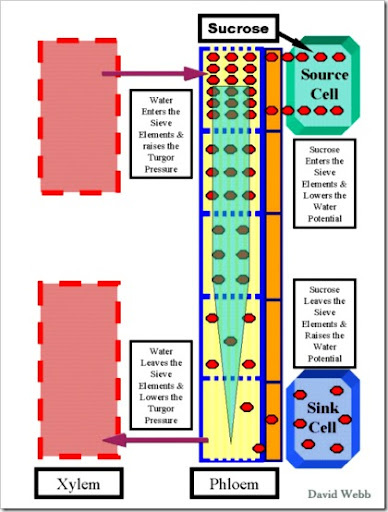
Evidence
Problem
A) Mechanism of water transpot along xylem:
1) Cohesion - tension developed from transpiration lead to massflow of water in xylem
*cohesive forve between water molecuke enables water inside xylem unbreakable like a chain.

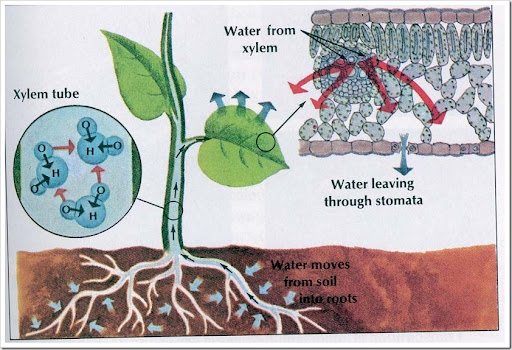

2) Root pressure:
- Active transport of mineral ion from surrounding parenchyma endodermis by root into root xylem, which lower the water potential in xylem.
- water is absorbed from soil to xylem by osmosis.
- a positive pressure is created to push water upward along the xylem.
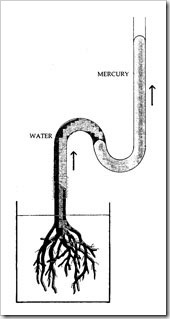
* only significant at night or soil moisture is high, which the transpiration pull is weak.
B) Movement of water and mineral salts across the root
From soil to root : (Active)
Root hair actively transpot mineral ion from soil to root hair, which lower the water potential in root hair vacuole. water is drawn across the cell well and the selectively permeable protoplasm by osmosis into vacuole.
From root hair to inner parenchyma : (Passive)
Water is than pass from root hair to parenchyma by the following mechanism:
* driving force: transpiration of xylem , xylem develop low water potential , which countious remove water from inner parenchyma to xylem , producing necessary osmotic potential gradient for (1) and water potential gradient for (2) and (3).
From inner parenchyma to xylem : (Active)
Active transpot of mineral salt into stele, creating water potential gradient across root. Water flow from inner parenchyma to xylem, through the cytoplasm of the endodermis because the Casparian Strip around the cell wall is impermeable to water.
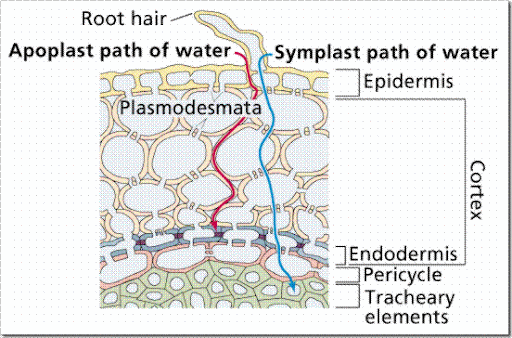
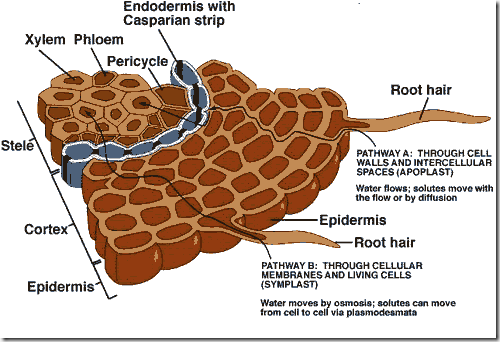
A) Guard cell:
B) lenticel:
-layers of dead cells with lots of air space, air diffuse in through the air space to reach the living tissue.
|    |
C) root: